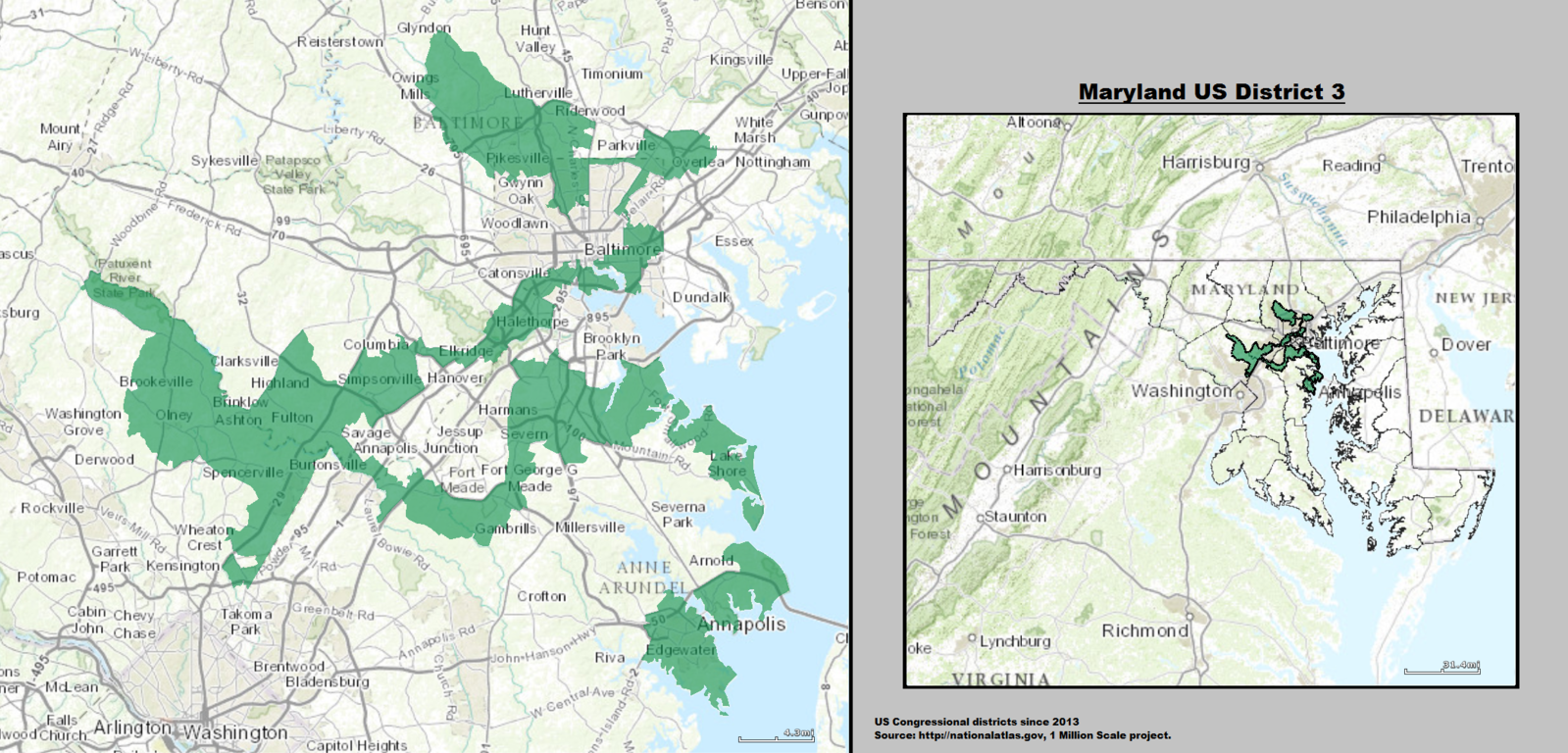As the 2016 legislative session comes to a close, many in Maryland will be wondering what happened to the proposals from Gov. Larry Hogan to bring an end to gerrymandering in this state. Gerrymandering, the intentional design of congressional districts to benefit one party or politician over another, takes place in many states across the country.
What’s wrong with gerrymandering? Simply put, it violates a core tenet of democratic government: People should be represented in the legislative body that makes laws on their behalf. When lines are intentionally drawn to put all people of the minority party in one district (called “packing”) or to split up members of the minority party into multiple districts where they will be outnumbered by members of the majority party (“cracking”), a state’s congressional representatives will no longer be true representatives of the state they serve.
Maryland is especially egregious in its attempt to negate the impact of Republicans in congressional elections. In the years since state Democratic legislators in Annapolis skewed the map in 2010, The Washington Post has given Maryland the embarrassing distinction as the most gerrymandered state in the country (although we are essentially tied with North Carolina). In a state that is 2-to-1 Democratic, our congressional delegation features seven Democrats for each Republican.
Looking at Maryland’s congressional district map, the borders of congressional districts speak to how deliberately Democratic legislators drew districts to benefit their own. District 6 packs all of rural, conservative Western Maryland in with just enough of liberal urban and suburban Montgomery County to make the district swing Democratic for John Delaney, who lately has spent more time attacking Gov. Hogan about supporting Donald Trump than legislating. (Newsflash: Hogan is not a Trump supporter.) District 1 is drawn strategically to give Republicans one congressional district with Andy Harris while not taking away too many Democratic votes from Districts 2 and 3.
District 3 should merit special attention and has been designated as the second-most gerrymandered district in America by The Washington Post’s Christopher Ingraham. A federal judge has referred to this preschooler-scribbled district as a “broken-wing pterodactyl,” and if you turn your head a little to the left if you can see the resemblance. District 3 would be funny if it wasn’t such a blatant attempt to disenfranchise Marylanders.
In an attempt to end some of the most obvious gerrymandering in the country, Gov. Hogan has proposed that Maryland establish a nonpartisan redistricting commission by 2020, when congressional lines will be redrawn to account for census estimates. The governor has asked that the Democratic-controlled legislature in Annapolis allow a referendum to be placed on the ballot in November to have voters decide whether or not they would want congressional lines drawn this way.
Unfortunately, the session will end Monday, likely without the issue being considered or voted on by the legislature. Why is the Democratic-controlled legislature refusing to take up the issue of redistricting reform?
Democratic leaders in Annapolis really have presented only one argument in opposition to redistricting reform: The state would be acting independently in fair redistricting — it would be a disadvantage for Democrats in Congress. They would be correct in saying this, and at the same time, the argument acknowledges that they have unfairly stacked the deck in favor of Democrats. Their fifth-grade justification in favor of gerrymandering — “The others are doing it, so we should be able to as well” — should sound strangely familiar to anyone who’s heard Trump discuss his stance on torture. Democratic legislators also seem to ignore the fact that 21 states have already acted to enact some form of bipartisan or nonpartisan redistricting process. Should we wait to be the 50th state to enact a smarter and more just redistricting process, or should we acknowledge the problem and move to fix it in the next redistricting cycle?
Hopefully everyone can recognize just how wrong the only defense Democratic leaders can provide for their actions truly is. The great irony of the Democrats’ unwillingness to work on this pro-democracy reform is that 75 percent of state residents prefer the use of a nonpartisan commission in the redistricting process compared with having elected officials draw the map, according to a recent poll by Goucher College. It’s important to note that most state Democrats recognize the importance of fair representation, and it appears that only their elected leaders are opposed.
The strategy of Democratic legislators on redistricting reform is obvious, as they have worked to ensure that Marylanders won’t have the option to approve a nonpartisan redistricting committee in a ballot referendum this November. They will likely continue to refuse a discussion on a nonpartisan commission as the state moves toward the 2018 elections and will try to deny Hogan a second term. With a Democratic governor in office in 2020, redistricting would be in the hands of a heavily Democratic legislature. The result would be 10 more years of blatant gerrymandering.
But what if Hogan wins? Democrats would then likely see the light and have a stunning reversal of policy to embrace a nonpartisan redistricting commission in 2020. But until then, Maryland’s Democratic legislators and leaders will pick the politically useful option over the morally just one. Let’s hope we only need to be embarrassed for four more years.
Sam Wallace is a senior government and politics major. He can be reached at swallacedbk@gmail.com.



